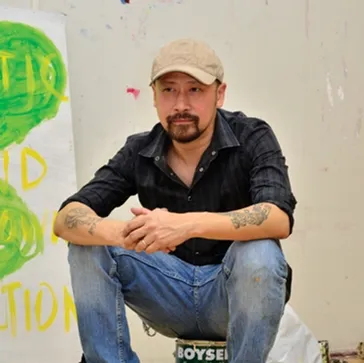
Manuel Ocampo
Manuel Ocampo is a Filipino-American artist whose work has left an indelible mark on the contemporary art world. Known for his provocative and visually striking creations, Ocampo's art transcends boundaries, challenging societal norms, and providing a unique perspective on cultural, political, and personal themes. The primary theme of his works intertwines sacred Baroque religious iconography with a secular political narrative.
Biography of Manuel Ocampo
Manuel Ocampo was born in 1965 in Quezon City, Philippines. He currently lives and works in Manila. At the age of 20, he relocated to Los Angeles and briefly pursued art studies at California State University, Bakersfield, all the while supporting himself by working at McDonald's.
By the early 1990s, he had firmly cemented his reputation, having been featured in Documenta IX (1992), the Venice Biennale (1993), and the groundbreaking exhibition "Helter Skelter: L.A. Art in the 1990s" at The Museum of Contemporary Art, Los Angeles (1992). During documenta 9 in Kassel, he inadvertently sparked controversy by incorporating swastika symbols into his artwork.
Manuel Ocampo showcased the Philippines at the 57th Venice Biennale in Italy with an exhibition titled "The Spectre of Comparison," curated by Joselina Cruz.
Ocampo has earned numerous prestigious awards, among them the 'National Endowment for the Arts,' 'Rome Prize in Visual Arts,' 'Reader's Digest Artists at Giverny Program,' and 'The Pollock-Krasner Foundation.'
In addition to his accolades, Manuel Ocampo has spearheaded a series of exhibitions showcasing contemporary Filipino art practices. This program, known as 'Bastards of Misrepresentation,' has been featured in institutions across Berlin, New York, and Sete.
Ocampo's artworks can be found in prominent collections, including those of the Fukuoka Asian Art Museum in Japan, the Museum of Contemporary Art in Los Angeles, the Whitney Museum of American Art in New York, and the Museo Nacional Centro de Arte Reina Sofia in Madrid, to name just a few.
Manuel Ocampo's Art Style
Manuel Ocampo's art practice is characterized by a rich tapestry of themes and symbols that serve as vehicles for socio-political criticism: religion and spirituality, secularism, and history. His style is fearless and provocative in the way he employs in his artworks a diverse array of popular iconography, including swastikas, crucifixes, teeth, feces, flowers, and emoticons.
Ocampo often revisits and references the art historical lineage of political allegorists, drawing inspiration from figures such as Leon Golub, Géricault, Goya, and Daumier, while also incorporating allusions to contemporary figures like political satirist R. Crumb and Modernist painter Philip Guston. In a manner reminiscent of both Martin Kippenberger and Philip Guston, Ocampo boldly confronts conventional iconography, as exemplified in his artwork "Virgin Destroyer (Ipis Ni Lupe)" created in 1995. In this piece, a cockroach is rendered in the iconic style of the Virgin of Guadalupe, juxtaposed with a vodka bottle, a plastic rosary, and a bloodied knife.
Years:
Born in 1965
Country:
Philippines, Quezon City
Gallery: